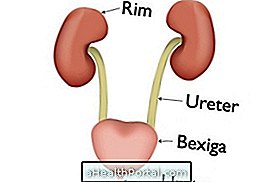The swollen or dilated kidney, also called hydronephrosis, usually occurs when there is some obstruction in the ureter, which is a canal that carries urine from the kidneys to the bladder. That is, when there is obstruction in the ureter the urine is retained in the kidneys, leaving them swollen. In addition to obstruction, urinary tract infections can also cause the kidney to become dilated. Understand more about hydronephrosis.
The symptoms of swollen kidney vary according to the cause, duration and location of the obstruction. The most common symptom is pain in the lumbar, also known as pain in the kidney, that can radiate to the groin when the cause is obstruction by account of stone in the kidney, for example. Other symptoms are:
- Fever;
- Chills;
- Pain and difficulty in urinating;
- Low back or kidney pain;
- Decreased urine volume;
- Urine with bright red blood or pink urine;
- Nausea and vomiting;
- Loss of appetite.
In the presence of these symptoms and in case of suspicion of swollen kidney, one can take a painkiller like Paracetamol of 1000 mg and go immediately to the hospital. Treatment is defined according to the cause. If left untreated, swollen kidney can lead to permanent kidney damage, increased risk of infection, and bleeding.


Main causes
Usually the swollen kidney happens because of obstructions in the kidneys, and may be due to:
- Presence of tumors;
- Kidney or ureter stone;
- Prostate enlargement in the case of men;
- Presence of clots;
- Constipation;
- Malformation of the renal system.
Urinary infections can also make the kidneys swollen as they can impair ureter function.
It is common during pregnancy that the women's kidney becomes swollen. This is because the growth of the fetus inside the uterus can press the urinary system and thus prevent the passage of urine, which eventually accumulates in the kidneys.
How is the diagnosis made?
The diagnosis of the swollen kidney is made by the nephrologist, who usually requests imaging tests such as ultrasonography, computed tomography or magnetic resonance imaging.
The doctor may also perform a cauterization of the bladder, which is a procedure in which a thin tube is inserted through the urethra in order to drain the urine. If too much urine can be drained, the kidney is swollen.
Treatment for swollen kidney
The treatment for swollen kidney will depend on its cause, but it can be done with medicines prescribed by the nephrologist or surgery, being essential to remove the accumulated urine in the kidney and the use of a urinary catheter.
Usually treatment is done with the use of antibiotics, such as amoxicillin or ciprofloxacin, to treat or prevent urinary infections.

























